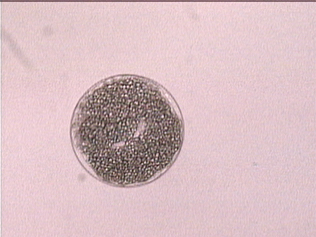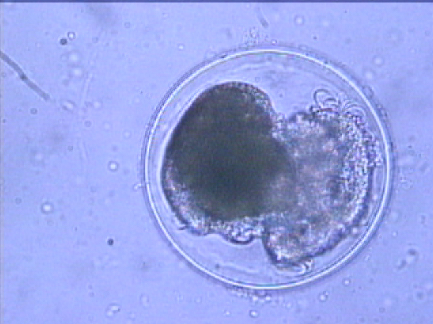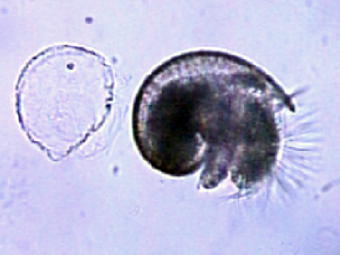

The majority of organisms living on floating docks reproduce sexually and have a larval phase that lives in the plankton. This seems reasonable given that most of the adult organisms living on the docks would not be able to reach their habitat except as planktonic larvae. After larvae recruit from the plankton and settle onto the surface of a tire or another organism living on a tire, animals like bryozoans may reproduce asexually, budding repeatedly to form large colonies of inter-connected units, called zooids.
Non-colonial organisms may also reproduce asexually. The sea anemone Metridium senile typifies this sort of facultatively sexual or asexual organism. Adult Metridium periodically release large numbers of sperm or eggs from their mouths. After sperm and egg meet in the water column and fertilization occurs, the resulting zygotes develop into swimming planula larvae that can drift great distances before settling onto a suitable substrate and metamorphosing into juvenile anemones. Once established, Metridium can then colonize nearby space by one of several means of asexual reproduction. For example, they can generate new individuals from fragments of the basal disc that they use to attach themselves to the substrate. Metridium may also undergo asexual fission through a slow process of cellular rearrangement and growth, during which time they appear as if they're being torn in two. The third means by which Metridium may reproduce asexually is by budding, a process in which miniature anemones develop on the stalk of an adult and break off to form new individuals after they've developed enough to catch and digest their own food.
Brooding vs. Non-brooding
Though mechanisms vary with different taxa, most organisms living on floating docks follow the general pattern of colonizing distant habitats with propagules from sexual interactions and then populating their local neighborhood with progeny from asexual processes. A common variation on this theme occurs in organisms like the colonial tunicate Distaplia occidentalis, which retains fertilized eggs in a specialized brood pouch derived from its atrial cavity. Fertilized eggs are retained until they develop through many embryonic stages into motile 'tadpole' larvae, and are only then released into the plankton. A wide variety of groups, from polychaete worms to brittle stars, contain taxa that brood.
Planktonic Phases
Planktonic marine larvae, like an anemone planula, are often quite different in appearance from the adult form they will eventually assume. Some larvae spend weeks or months in the plankton and feed actively, whereas others settle within hours or days and rely on yolk reserves for food until they metamorphose. Barnacle nauplii and crab zooea are common in the waters around floating docks. The swimming barnacle larvae enjoy their mobility until they complete development and find a desirable substrate, to which they subsequently cement their heads with a compound produced by glands associated with their first antennae. The larvae of green sea urchins (Strongylocentrotus droebachiensis), which look radically different from their parents, may also be found. During their pluteus stage they exhibit bilateral symmetry, and don't attain the pentaradial symmetry of the adult urchin form until metamorphosis.
Case
Study: Environmental Effects on Development 
Lacuna vincta (right) is a small snail commonly found on many of the species of algae that grow on floating docks. This species produces doughnut-shaped yellow or green egg masses, which after 7-11 days hatch into swimming, feeding veliger larvae. Lacuna snails can live in a wide range of conditions, and can be found subtidally and intertidally in many habitats on San Juan Island. Many of these other habitats, like Argyle Creek, are subject to much greater temperature fluctuations than are the floating docks.
Snails inhabiting these
different environments must necessarily lay their eggs in them as well.
A small study was undertaken to determine whether a difference in a single
physical parameter, temperature, could significantly affect developmental
rates. A newly-laid egg mass was collected from algae growing on a floating
dock and cut in half. One half was kept in a sea table at 8°
C, and the other half was kept in seawater at room temperature (~20°
C). Developmental progress in each group of eggs was photographically
documented at 24 hour intervals until hatching, with the results shown
below at 400X magnification:

|
|
|
|
| Day 1 |  |
 |
| Day 2 |  |
 |
| Day 3 |  |
 |
| Day 4 |  |
 |
| Day 5 |  |
 |
| Day 6 |  |
Hatching! |
| Day 7 |  |
|
| Day 8 |  |